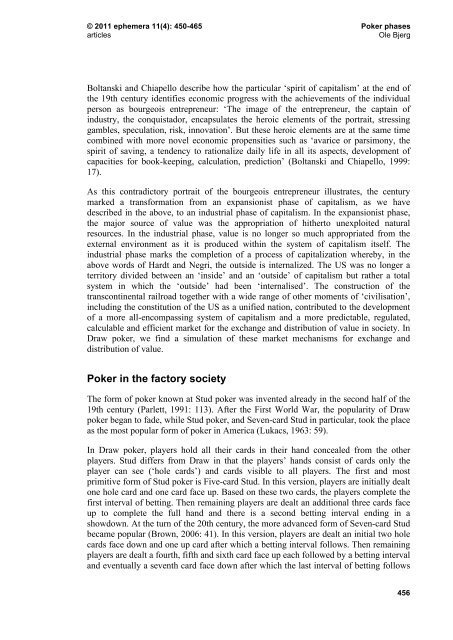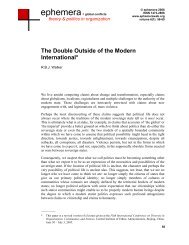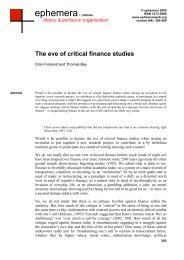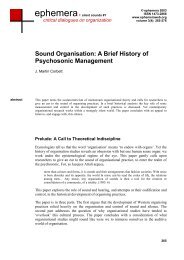Work, play and boredom - Ephemera
Work, play and boredom - Ephemera
Work, play and boredom - Ephemera
You also want an ePaper? Increase the reach of your titles
YUMPU automatically turns print PDFs into web optimized ePapers that Google loves.
© 2011 ephemera 11(4): 450-465 Poker phases<br />
articles Ole Bjerg<br />
Boltanski <strong>and</strong> Chiapello describe how the particular ‘spirit of capitalism’ at the end of<br />
the 19th century identifies economic progress with the achievements of the individual<br />
person as bourgeois entrepreneur: ‘The image of the entrepreneur, the captain of<br />
industry, the conquistador, encapsulates the heroic elements of the portrait, stressing<br />
gambles, speculation, risk, innovation’. But these heroic elements are at the same time<br />
combined with more novel economic propensities such as ‘avarice or parsimony, the<br />
spirit of saving, a tendency to rationalize daily life in all its aspects, development of<br />
capacities for book-keeping, calculation, prediction’ (Boltanski <strong>and</strong> Chiapello, 1999:<br />
17).<br />
As this contradictory portrait of the bourgeois entrepreneur illustrates, the century<br />
marked a transformation from an expansionist phase of capitalism, as we have<br />
described in the above, to an industrial phase of capitalism. In the expansionist phase,<br />
the major source of value was the appropriation of hitherto unexploited natural<br />
resources. In the industrial phase, value is no longer so much appropriated from the<br />
external environment as it is produced within the system of capitalism itself. The<br />
industrial phase marks the completion of a process of capitalization whereby, in the<br />
above words of Hardt <strong>and</strong> Negri, the outside is internalized. The US was no longer a<br />
territory divided between an ‘inside’ <strong>and</strong> an ‘outside’ of capitalism but rather a total<br />
system in which the ‘outside’ had been ‘internalised’. The construction of the<br />
transcontinental railroad together with a wide range of other moments of ‘civilisation’,<br />
including the constitution of the US as a unified nation, contributed to the development<br />
of a more all-encompassing system of capitalism <strong>and</strong> a more predictable, regulated,<br />
calculable <strong>and</strong> efficient market for the exchange <strong>and</strong> distribution of value in society. In<br />
Draw poker, we find a simulation of these market mechanisms for exchange <strong>and</strong><br />
distribution of value.<br />
Poker in the factory society<br />
The form of poker known at Stud poker was invented already in the second half of the<br />
19th century (Parlett, 1991: 113). After the First World War, the popularity of Draw<br />
poker began to fade, while Stud poker, <strong>and</strong> Seven-card Stud in particular, took the place<br />
as the most popular form of poker in America (Lukacs, 1963: 59).<br />
In Draw poker, <strong>play</strong>ers hold all their cards in their h<strong>and</strong> concealed from the other<br />
<strong>play</strong>ers. Stud differs from Draw in that the <strong>play</strong>ers’ h<strong>and</strong>s consist of cards only the<br />
<strong>play</strong>er can see (‘hole cards’) <strong>and</strong> cards visible to all <strong>play</strong>ers. The first <strong>and</strong> most<br />
primitive form of Stud poker is Five-card Stud. In this version, <strong>play</strong>ers are initially dealt<br />
one hole card <strong>and</strong> one card face up. Based on these two cards, the <strong>play</strong>ers complete the<br />
first interval of betting. Then remaining <strong>play</strong>ers are dealt an additional three cards face<br />
up to complete the full h<strong>and</strong> <strong>and</strong> there is a second betting interval ending in a<br />
showdown. At the turn of the 20th century, the more advanced form of Seven-card Stud<br />
became popular (Brown, 2006: 41). In this version, <strong>play</strong>ers are dealt an initial two hole<br />
cards face down <strong>and</strong> one up card after which a betting interval follows. Then remaining<br />
<strong>play</strong>ers are dealt a fourth, fifth <strong>and</strong> sixth card face up each followed by a betting interval<br />
<strong>and</strong> eventually a seventh card face down after which the last interval of betting follows<br />
456








